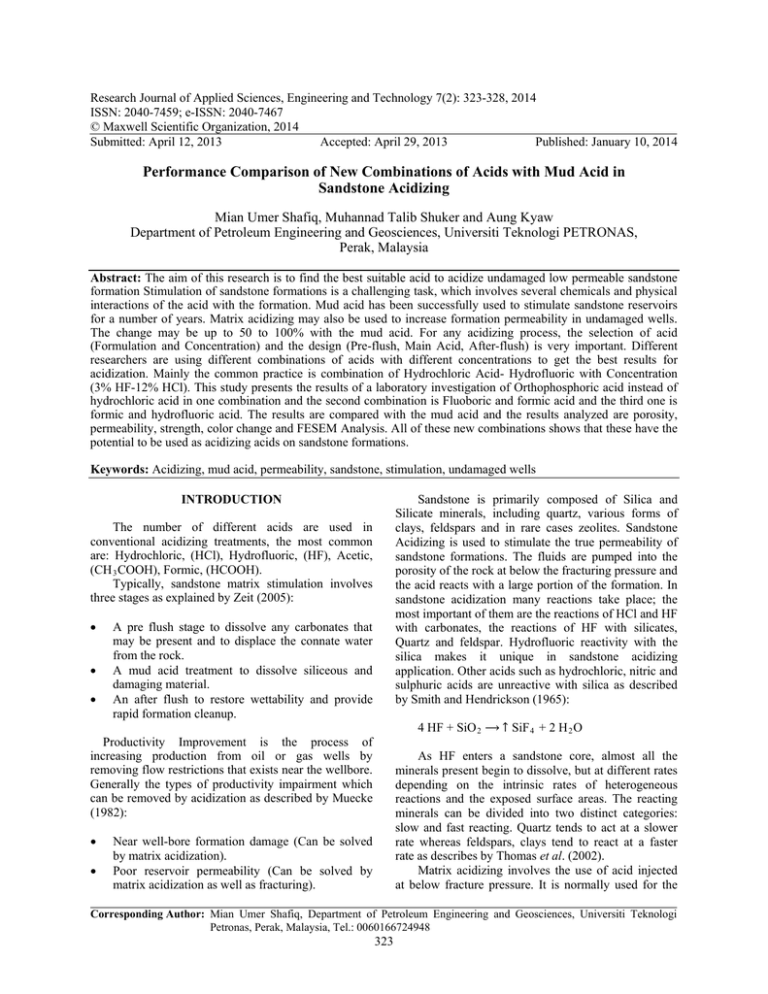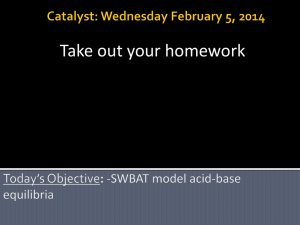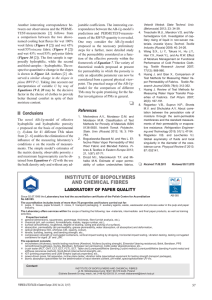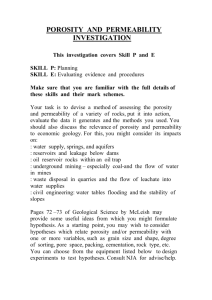Research Journal of Applied Sciences, Engineering and Technology 7(2): 323-328,... ISSN: 2040-7459; e-ISSN: 2040-7467
advertisement

Research Journal of Applied Sciences, Engineering and Technology 7(2): 323-328, 2014 ISSN: 2040-7459; e-ISSN: 2040-7467 © Maxwell Scientific Organization, 2014 Submitted: April 12, 2013 Accepted: April 29, 2013 Published: January 10, 2014 Performance Comparison of New Combinations of Acids with Mud Acid in Sandstone Acidizing Mian Umer Shafiq, Muhannad Talib Shuker and Aung Kyaw Department of Petroleum Engineering and Geosciences, Universiti Teknologi PETRONAS, Perak, Malaysia Abstract: The aim of this research is to find the best suitable acid to acidize undamaged low permeable sandstone formation Stimulation of sandstone formations is a challenging task, which involves several chemicals and physical interactions of the acid with the formation. Mud acid has been successfully used to stimulate sandstone reservoirs for a number of years. Matrix acidizing may also be used to increase formation permeability in undamaged wells. The change may be up to 50 to 100% with the mud acid. For any acidizing process, the selection of acid (Formulation and Concentration) and the design (Pre-flush, Main Acid, After-flush) is very important. Different researchers are using different combinations of acids with different concentrations to get the best results for acidization. Mainly the common practice is combination of Hydrochloric Acid- Hydrofluoric with Concentration (3% HF-12% HCl). This study presents the results of a laboratory investigation of Orthophosphoric acid instead of hydrochloric acid in one combination and the second combination is Fluoboric and formic acid and the third one is formic and hydrofluoric acid. The results are compared with the mud acid and the results analyzed are porosity, permeability, strength, color change and FESEM Analysis. All of these new combinations shows that these have the potential to be used as acidizing acids on sandstone formations. Keywords: Acidizing, mud acid, permeability, sandstone, stimulation, undamaged wells INTRODUCTION Sandstone is primarily composed of Silica and Silicate minerals, including quartz, various forms of clays, feldspars and in rare cases zeolites. Sandstone Acidizing is used to stimulate the true permeability of sandstone formations. The fluids are pumped into the porosity of the rock at below the fracturing pressure and the acid reacts with a large portion of the formation. In sandstone acidization many reactions take place; the most important of them are the reactions of HCl and HF with carbonates, the reactions of HF with silicates, Quartz and feldspar. Hydrofluoric reactivity with the silica makes it unique in sandstone acidizing application. Other acids such as hydrochloric, nitric and sulphuric acids are unreactive with silica as described by Smith and Hendrickson (1965): The number of different acids are used in conventional acidizing treatments, the most common are: Hydrochloric, (HCl), Hydrofluoric, (HF), Acetic, (CH 3 COOH), Formic, (HCOOH). Typically, sandstone matrix stimulation involves three stages as explained by Zeit (2005): • • • A pre flush stage to dissolve any carbonates that may be present and to displace the connate water from the rock. A mud acid treatment to dissolve siliceous and damaging material. An after flush to restore wettability and provide rapid formation cleanup. 4 HF + SiO 2 ⟶ ↑ SiF 4 + 2 H 2 O Productivity Improvement is the process of increasing production from oil or gas wells by removing flow restrictions that exists near the wellbore. Generally the types of productivity impairment which can be removed by acidization as described by Muecke (1982): • • As HF enters a sandstone core, almost all the minerals present begin to dissolve, but at different rates depending on the intrinsic rates of heterogeneous reactions and the exposed surface areas. The reacting minerals can be divided into two distinct categories: slow and fast reacting. Quartz tends to act at a slower rate whereas feldspars, clays tend to react at a faster rate as describes by Thomas et al. (2002). Matrix acidizing involves the use of acid injected at below fracture pressure. It is normally used for the Near well-bore formation damage (Can be solved by matrix acidization). Poor reservoir permeability (Can be solved by matrix acidization as well as fracturing). Corresponding Author: Mian Umer Shafiq, Department of Petroleum Engineering and Geosciences, Universiti Teknologi Petronas, Perak, Malaysia, Tel.: 0060166724948 323 Res. J. App. Sci. Eng. Technol., 7(2): 323-328, 2014 removal of skin damage associated with work-over, well killing or injection fluids and by precipitation of scale deposits in tubular, the wellbore or within the formation explained by Hill et al. (1982). Matrix acidizing may also be used to increase formation permeability in undamaged wells. Where damage is thought to exist within the formation, the aim of the treatment is to achieve more or less radial acid penetration deep into the formation to increase the formation permeability around the wellbore. There is a practical limit of about a 50% increase in injectivity or productivity of undamaged oil or water wells which can be achieved using matrix stimulation (Cleansorb, 2006). Though recent works contributed significantly to acidizing technology, their remained many unexplored facts of this complex stimulation mechanism. Most of the researchers are doing research on the mud acid system, its reactions and mechanism. Most of them are researching on the way the mud acid reacts with the damage and its effectiveness in removing it. The problem is that there is no extensive or detailed research done with other acids in removing the damage and to increase the permeability of a poor permeable reservoir, even with the mud acid no research is done to show the increase in the permeability and porosity in poor permeable reservoir. The objective of the present study is to access the performance of acids other than which is used now a day. This research presents the results of a laboratory investigation of a sandstone acidizing fluids designed to address some of the problems associated with conventional sandstone acidizing fluids. Concentration of acids is already provided by supplier: HCl is 37%, HF is 48%, HBF 4 is 50%, HCOOH is 100% and H 3 PO 4 is 100%. For example: If combination is 3% HF: 12%HCl, the calculations are as follows: For HCl M1V1 = M2V2 (37) V 1 = (12) (175) V 1 = 56.75 mL As, there is one liter of solution, the remaining volume will be filled in by the distilled water. Volume of water = 175 - 56.75 - 10.75 = 107.5 mL. Saturation of core sample: • • • • • • • EXPERIMENTAL WORK • • • • Prepare the desiccators and vacuum pump. Immerse the sample in 175 mL of acid solution. Place the lid on desiccators and open the tap and cover with appropriate sized safety cage. Connect the tap to the vacuum pump and open the tap slowly to evacuate the desiccators. After the samples had been dried, close the tap and disconnect the vacuum supply. Repeat the entire step by using all the acid solutions on core samples. Measure permeability, porosity, minerology and strength of the samples before and after the acidizing. RESULTS AND DISCUSSION The core samples used having permeability less than 100 md as matrix acidizing is done to increase the permeability, if permeability is already high then matrix acidizing is not done. Acidizing has been performed with different concentrations of (H 3 PO 4 /HF, HBF 4 /HCOOH, HF/HCOOH and HF/HCl. For the purpose of acidizing, we have to do the saturation of the core sample for some time under vacuum conditions to speed up the process. Desiccators are used in order to create the vacuum and saturation time is 4 h to ensure that maximum acid should enter into the core sample. The core is dried before and after the acidizing process for 24 h at 80°C. The size of the core is 3 inch in length and 1.5" in Diameter. The total volume used is 175 mL which includes both acids and distilled water. Porosity calculations: Analysis: • • • Acid volume calculations: Acid volume calculations have been made using the formula: M1V1 = M2V2 For HF M1V1 = M2V2 (48) V 1 = (3) (175) V 1 = 10.75 mL (1) 324 From the Table 1, it is clear that the porosity increase with the new acid combination HF: H 3 PO 4 is more as compared to mud acid. The maximum increase is with 3% HF: 9% H 3 PO 4 which is almost 100% and 1.5% HF: 9% H 3 PO 4 also shows good results as compare to other combinations. But in this combination if the concentration of H 3 PO 4 is increased then the change in the porosity decreased. The other combination showing reasonable result is HBF 4 : HCOOH: From results it is clear that the change with the combination of HBF 4 : HCOOH with each concentration is almost same. Each combination shows good results and there is not much difference with the change in the concentrations of the acids. The combination HF: HCOOH show reasonable results. Although the percentage change is better than mud acid but it is not better than the last combination discussed. The same is the case with Res. J. App. Sci. Eng. Technol., 7(2): 323-328, 2014 Table 1: Porosity results before and after acidizing Combination used Initial porosity 3% HF: 12% HCl 10.28 3% HF: 12% HCOOH 10.11 3% HF: 9% HCOOH 10.98 1.5% HF: 9% HCOOH 10.52 3% HF: 12% H 3 PO 4 9.89 3% HF: 9% H 3 PO 4 9.17 1.5% HF: 9% H 3 PO 4 10.01 3% HBF 4 : 12% HCOOH 10.56 3% HBF 4 : 9% HCOOH 10.44 1.5% HBF 4 : 9% HCOOH 10.75 Final porosity 15.120 14.220 16.500 16.170 14.319 16.110 15.530 16.950 15.580 16.140 Table 2: Results of permeability before and after acidizing Combination used Initial permeability Final permeability 3% HF: 12% HCl 70.26 123.876 3% HF: 12% HCOOH 71.58 102.511 3% HF: 9% HCOOH 74.36 145.278 1.5% HF: 9% HCOOH 72.25 113.474 3% HF: 12% H 3 PO 4 71.46 120.305 3% HF: 9% H 3 PO 4 70.50 148.223 1.5% HF: 9% H 3 PO 4 72.89 106.868 3% HBF 4 : 12% HCOOH 71.81 147.260 3% HBF 4 : 9% HCOOH 71.82 145.278 1.5% HBF 4 : 9% HCOOH 71.78 125.170 Percentage change 47.08 40.65 50.27 53.71 44.78 75.68 55.14 60.51 49.23 50.14 Percentage change 76.31 43.21 95.37 57.06 68.35 110.25 46.62 105.07 102.28 74.38 Final porosity (after flush) 16.85 16.79 18.20 18.02 15.23 18.10 17.73 17.79 17.85 17.99 Percentage change 63.91 66.07 65.76 71.29 53.99 97.38 77.12 68.47 70.98 67.35 Final permeability (after flush) 141.76 140.68 163.24 132.58 131.47 165.90 115.29 164.96 162.32 140.25 Percentage change 101.76 96.54 119.53 83.50 83.98 135.32 58.17 129.72 126.01 95.39 The Fig. 1 shows the three curves for the change in the porosity with different combinations used. One combination is 3% HF: 12% HCl which is for the comparison, the red one is the 3% HF: 9% H 3 PO 4 which gives the best results and the 3rd one is combination of 3% HBF 4 and 12% HCOOH. This combination was given priority over 3% HBF 4 and 9% HCOOH (although the final results of later combination was better) because it shows good values than the later one before after flush. Permeability calculations: Analysis: Fig. 1: Comparison of change of porosity between three best combinations • Fig. 2: Comparison of change of permeability between three best combinations From Table 2, the change in the permeability in many cases is more than the mud acid. But with the combination 3% HF: 9% H 3 PO 4 the permeability change is more and is almost 110% before after flush. The other concentrations of this combination didn’t show better results as compared to mud acid. 3% HF: 9% HCOOH also shows much increase in permeability as compared to mud acid and the percentage change is 95% but the other two concentration of this combination doesn’t show good results. 3% HBF 4 : 12% HCOOH the permeability change is almost 100% changed than original. So these combinations can be used as main acid for sandstone acidizing for matrix acidizing, for reservoirs whose initial permeability is less than 100 md. the HBF 4 : HCOOH, in all these combinations the results are in the range of 65-70%, while mud acid results are 63%. So, these combinations can also be a part of main acid treatment instead of the mud acid. The Fig. 2 shows the three curves for the change in the permeability with different combinations used. One combination is 3% HF: 12% HCl which is for the comparison, the red one is the 3% HF: 9% H 3 PO 4 which gives the best results and the 3rd one is • • 325 Res. J. App. Sci. Eng. Technol., 7(2): 323-328, 2014 Table 3: Minerological composition before and after acidizing Initial composition -----------------------------------------------------------------Elements Oxygen (O) Silicon (Si) Aluminum (Al) Potassium (K) Iron (Fe) Fluorine (F) Phosphorus (P) Chlorine (Cl) Calcium (Ca) Carbon (C) Magnesium (Mg) Percentage weight 55.94 38.05 2.95 1.00 0.96 0.00 0.00 0.00 2.04 0.00 0.00 HF+HCl 51.03 27.02 1.89 0.90 1.28 0.00 0.00 1.17 0.81 15.92 0.00 Table 4: Results of compressive strength before and after acidizing Combination used Initial peak load Final peak load HF: HCl (3:12) 53.1 39.6 HF: H 3 PO 4 (3:12) 53.1 42.7 HF: H 3 PO 4 (3:9) 53.1 39.5 HF: H 3 PO 4 (1.5:9) 53.1 41.7 HBF 4 : HCOOH (3:12) 53.1 33.7 HBF 4 : HCOOH (3:9) 53.1 38.4 HBF 4 : HCOOH (1.5:9) 53.1 47.7 HF: HCOOH (3:12) 53.1 45.9 HF: HCOOH (3:9) 53.1 36.5 HF: HCOOH (1.5:9) 53.1 45.0 HF+H 3 PO 4 50.97 34.27 2.49 0.86 0.78 7.28 1.12 0.87 1.36 0.00 0.00 Percentage change -25.42 -19.59 -25.61 -21.47 -36.54 -27.68 -10.17 -13.56 -31.26 -15.25 combination of 3% HBF 4 and 12% HCOOH. Although the results of 3% HBF 4 : 9% HCOOH are similar to previous one but due to porosity results preference should be given to 3% HBF4: 12% HCOOH. Initial stress 55.15 55.15 55.15 55.15 55.15 55.15 55.15 55.15 55.15 55.15 HF+HCOOH 56.42 37.54 2.08 0.75 1.79 0.00 0.00 0.85 0.57 0.00 0.00 Final stress 41.40 44.40 41.20 43.40 35.20 41.10 49.50 47.75 38.20 46.81 HBF 4 +HCOO H 55.95 36.34 2.30 0.95 2.36 0.00 0.00 0.96 1.12 0.00 0.00 Percentage change -24.93 -19.49 -25.30 -21.31 -36.17 -25.48 -10.25 -13.42 -30.73 -15.12 is no carbon found. Traces of phosphorous and fluorine are also found, amount of iron has been decreased. Analysis: Mineralogy measurement: Field Emission Scanning Electron Microscope (FESEM) was used to check the elemental composition before and after the acidizing: • • • • • • Initial composition: First of all let’s see the initial mineralogical composition. It contains almost 56% oxygen in different forms such as Al 2 O 3 , SiO 2 and Feldspar etc. Second main Component is Silicon which is almost 38%. So in total we can say that 94% of the sample contains silicon and oxygen. Aluminum, Calcium is also present in large ratio as compared to potassium and Iron. HF+HCl: It dissolves a large quantity of silicon, small quantities of Aluminum and Calcium, but the iron contents has been increased which is the indication of corrosion materials present in it. But a large amount of carbon has been detected which was not present initially. It means that carbonates are dissolved leaving carbon traces behind. HF+H 3 PO 4 : It also dissolves amount of silicon but less than mud acid, but in this case there is no carbon found. Traces of phosphorous and fluorine are also found, amount of iron has been decreased. HF+HCOOH: It also dissolves amount of silicon but less than mud acid, but in this case there is no carbon found. No Traces of phosphorous and fluorine are also found, amount of iron has been decreased. HBF 4 +HCOOH: It also dissolves amount of silicon but less than mud acid, but in this case there • From Table 3, Carbon is only present after combination of HF+HCl and there is less change in the values of permeability and porosity after this combinations used. Carbon is not present after the other combinations used. It also means those carbon components are a reason for less permeability increase and this carbon is present only after when HCl is used. In all the combinations used except (HF+H 3 PO 4 ), one thing is common, which is the increase in the iron component. It means that we need to use corrosion inhibitor during the injection of these acids into the well because they can cause corrosion of the pipes and other things. But in the case of phosphoric acid, the iron component has been decreased which is the opposite as compared to other combinations. It means there is no need of corrosion inhibitor when phosphoric acid has acid has been used as it can itself react as a corrosion inhibitor. Compressive strength calculations: From Table 4 tests results shows clearly that the combination (HF: H 3 PO 4 ) with which the porosity and permeability change is the maximum; there is also about 25% change in strength. But the strength change with mud acid is also same but in that case the porosity permeability change is less as compared to that acid. This may be due to the reason that precipitate may form due to very fast reaction of the HF acid. This also shows that the 326 Res. J. App. Sci. Eng. Technol., 7(2): 323-328, 2014 • • Fig. 3: Core reacted with HF: HCl • Fig. 4: Core reacted with HBF 4 : HCOOH • Fig. 5: Core reacted with HF: H 3 PO 4 • Fig. 6: Core reacted with HF: HCOOH action of H 3 PO 4 as a buffer solution is very effective and also better than HCl acid. But with the combination of HBF 4 : HCOOH (3:12), the change is maximum and with this combination permeability and porosity change is also high which means that this acid although changes porosity and permeability but meanwhile it is weakening the rock by dissolving the components. With the other combination having good results, the strength change is also the maximum. CONCLUSION • o o • Color change test: • After the evaporation, the products formed due to the reaction remain there in the sample which causes the change in the color of the sample. This change in color of sample will tell us that how much is the penetration of the acid in the core sample. There will be a change in the color, wherever the acid reacts inside the sample. First of all from the sample of HF: HCl (Fig. 3), The change in color is more dark at the outer edges, means the reaction is fast and it is reacting with most of the core in the start and it also penetrated into the reservoir and from figure it is clear that some portions are unreacted means most of the acid was being used in the start due to very fast reaction of mud acid. Now from HBF 4 : HCOOH (Fig. 4), The change in color is more dark at the outer edges, means the reaction is fast and it is reacting with most of the core in the start and it also penetrated into the reservoir and from figure it is clear that there is a change in color of the rock and the change is uniform throughout except the edges and most of the rock has reacted with acid. From HF: H 3 PO 4 (Fig. 5), the main difference between this combination and others is that it dissolves the iron contents which are formed by the pre flush, so means that this acid cannot corrode the tubing and other things, but it has the capacity to dissolve iron contents. And from figure it is also clear that the penetration of the acid is also maximum; there is a change in color in the whole of the core sample. Now from HBF 4 : HCOOH (Fig. 6), The change in color is more dark at the outer edges, means the reaction is fast and it is reacting with most of the core in the start and it also penetrated into the reservoir and from figure it is clear that there is a change in color of the rock and the change is uniform throughout except the edges and most of the rock has reacted with acid. After the acidizing process the core is put in the oven for 24 h to evaporate any acid or liquid present inside the pores of the sample. 327 Orthophosphoric acid has two advantages over HCI: Deep penetration into the formation can be achieved Corrosion inhibitors are not required Comparison to HCI: HCl is particularly corrosive to steel, aluminum or chromium plated equipment which are components of many pumps. Expensive corrosion inhibitors need to be used in these circumstances. This cost becomes very significant when treating formations at higher temperatures Res. J. App. Sci. Eng. Technol., 7(2): 323-328, 2014 • • REFERENCES due to the requirement for higher doses of corrosion inhibitor. Corrosion inhibitors are not required with Orthophosphoric Acid. It can be seen in the mineralogy tests and color change tests: Also there is no carbon detected when Orthophosphoric acid and formic acid are used, it is present when HCl is used and there is a less increase in the permeability and porosity values when HCl is present. All the results calculated and observed, it can be said that we can also use combinations of (Hydrofluoric and phosphoric acid) and (Fluoboric and Formic Acid) as a main acid in sandstone acidizing. Cleansorb, 2006. Acidizing oil and gas reservoirs: Current practice and applications of the Arcasolve Acidizing Process. Arcasolve Technical Document ATD-B1, Cleansorb Ltd., 2006. Hill, A.D., D.M. Lindsay, I.H. Silberberg and R.S. Schechter, 1982. Theoretical and Experimental Studies of Sandstone Acidizing. SPE Paper No. 6607, SPEJ, Feb. Muecke, T.W., 1982. Principles of Acid Stimulation. Proceeding of the International Petroleum Exhibition and Technical Symposium, Beijing, China, March 17-24. Smith, C.F. and A.R. Hendrickson, 1965. Hydrofluoric acid stimulation of sandstone reservoirs. J. Petrol. Technol., 17(2): 215-222. Thomas, R.L., H.A. Nasr-El-Din, S. Mehta, V. Hilab and J.D. Lynn, 2002. The impact of HCl to HF ratio on hydrated silica formation during the acidizing of a high temperature sandstone gas reservoir in Saudi Arabia. Proceeding of the SPE Annual Technical Conference and Exhibition. 29 September-2 October 2002, San Antonio, Texas. Zeit, B., 2005. Stimulation of sandstone reservoirs. SPE Technology Transfer Workshop (TTW). ACKNOWLEDGMENT I am very thankful to my supervisor and cosupervisor for helping me in this research work. I am also thankful to the lab technicians for helping me doing my experiments smoothly and on tine and last but not the least I am very grateful to UTP for providing me funds and necessary apparatus for completing this research. 328




